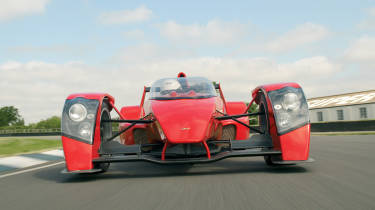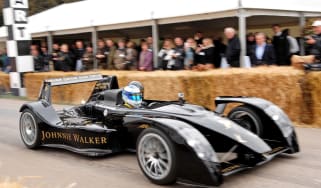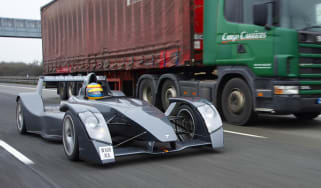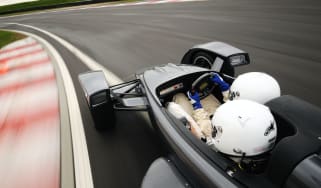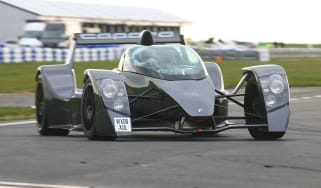Caparo T1
It's as close as you'll get to an F1 car for the road, but is the extraordinary Caparo T1 a supercar too far?
The media has beaten a path to Goodwood, tongues all but dragging along the ground. The excuse, ostensibly, is for us to witness the T1 prototypes undergoing final shakedown tests before the first customer car is delivered in July. No one cares about that. The real reason we’re here is we want that ride. And one by one, according to an impressively specific schedule that we’re handed as we register at the Jackie Stewart Centre, our dreams will be granted…
Things are running late. This is no real surprise to anyone present, and no real concern. Such events always run late. The more intricate the planning in its military precision, the later things run.
My turn in the passenger seat of the white prototype (the one with the current-spec 570bhp engine) is scheduled for 10.45am on the nail. It’s now 11.30am and the red car, the one with the 480bhp supercharged 2.4 V8, has already expired with alternator trouble after completing a dozen laps at photographic tracking speed, while the white one is stationary in the pitlane, unable to select its full complement of gears. Men with laptops and puzzled expressions are hunched around it like surgeons around a body on an operating table. A temporary hiatus, Sean Butcher assures us. Both cars will be up and running soon.
The downtime is actually quite useful for exploring the head of hype that has built up to this point. Ben Scott-Geddes certainly wasn’t joking when he said the T1 is an F1 car for the road, but I’m equally sure he wasn’t being wholly serious, either. For the sake of sanity, let’s remind ourselves what an utterly astonishing machine the modern F1 car is.
In the 5.7 seconds it takes the T1 to accelerate to 100mph (the best time Caparo has achieved in testing so far – some 0.8sec shy of the projected time), an F1 car will have blasted to 100mph and braked to a standstill again, with a few tenths to spare. Looked at another way, forget the braking, just five seconds gets you to 125mph in the F1 car. It has a power/weight ratio of over 1400bhp/ton, after all. Staggering as the T1’s claimed acceleration is, it would be a moving chicane on the grid at the start of an F1 race.
Cornering then. Given that most of us have never experienced more than 1g of lateral acceleration in a road car, 3g seems outrageous. And so it is by road-car standards. But the F1 car is in a different league again: 6g has been recorded at Suzuka’s 130R corner and 4-5g is normal in fast turns. It’s the same with braking: 3g might be enough to suck the moisture from your eyeballs, but 5-6g presumably bounces them off your visor. Be honest, you don’t want that, and neither do I. If you do, then buy a retired F1 car. For half the price of the T1.
So, talk of an F1 car for the road is fanciful. A GP2 Series car, maybe, but that’s still far too much for any previous supercar, of course; nothing gets close to the T1’s headline 1053bhp/ton. Interestingly, though, this figure was an early estimate, based on the T1’s dry weight, i.e. shorn of all fluids. ‘Wet’, with roughly a half-load of fuel, the T1 recently weighed in at 672kg. Bang goes 1053bhp/ton, the power/weight ratio dropping to a slightly less eye-catching 862bhp/ton.
Things get more interesting still in real-world conditions. For the sake of argument, let’s say the T1 is carrying two 95kg (15 stone) occupants, adding 190kg to the total weight. As you might expect, this plays havoc with the figures, dropping the T1’s headline statistic to 672bhp/ton. Still more than plenty, of course, but no longer, in like-for-like comparisons, the crushing advantage hitherto assumed.
Take the biofuel-burning Koenigsegg CCXR, which has 1018bhp and a with-fluids weight of 1180kg. That’s 876bhp/ton, as near as dammit the same as a passengerless T1. Add 190kg of human baggage to the CCXR and you get 1370kg. Do the sums and the T1 isn’t just on the back foot but soundly beaten: 672bhp/ton plays the Swedish supercar’s 755bhp/ton. It’s the fat-man-on-a-go-kart syndrome. Driver mass has a big effect on an ultra-light vehicle: it goes slower.
When Caparo finally gets round to fitting a VBOX to the T1 (don’t worry, we’ve already offered ours) it may yet turn out to have the drop on what is currently reckoned to be the world’s fastest production car, the Bugatti Veyron. The truly remarkable thing is that the Bugatti goes so fast with a ‘mere’ 521bhp/ton. Partly it’s down to torque and all-wheel-drive traction (922lb ft at 2200rpm versus 310lb ft at 9000rpm) and partly the fact that the Veyron’s quoted 1000bhp is somewhat conservative: 1150bhp, Bugatti insiders tell us, is closer to the mark.
Lunch comes and goes. I hang round the pits, helmet on standby, waiting for any signs of mechanical life. And there it is. A cough and a bark, a little smoke, a whoop of revs – hardly musical, but hard and mean – and thumbs are going up all over the place.
Richard Butler is looking for a volunteer to strap in, the schedule having long since been screwed up into a tiny ball, and I’m there, chin-strap already fastened, accepting a helping shoulder as I attempt to thread my legs down into the canoe-like tub.
Even though I’m not rubbing shoulders with my driver, Rob from Mallory Park-based Cirtek Motorsport, the company helping Caparo with final development, it’s cheek-pursingly tight in the cabin, though the view is great, not least of the driver’s concentrated exertions at the tiny, F1-style wheel. With the six-point harness digging reassuringly into my flesh, we chunter down the pitlane in a series of small lunges, every minuscule movement of the throttle seemingly translated into leash-straining violence. Twenty metres from the track entrance I tense myself against the anticipated body-slam of unbridled, 700-ish-bhp-per-ton acceleration.
Then, out of nowhere, we’re overtaken by two family hatchbacks, photographers hanging out of every orifice, wildly gesticulating to the driver, and we attack the next two laps at an even 40mph. Once I’ve got over my surprise that the T1 can travel at an even 40mph, the remainder of my time in the T1 tells me just one thing. You would no more want to drive the Caparo on the road than eat your lunch inside a working cement mixer.
The most remarkable aspect of the experience is the sheer range of structure-borne vibrations the T1 can generate at suburban traffic speeds, from the vision blurring to the toe-tingling to the bum-numbing. This thing’s a racing car, red and raw, don’t let anyone tell you any different. My amazement at driver Rob’s restraint is trumped only by that of being flagged in after just two laps. Game over.
Others are already forming a disorderly queue and, to my dismay, annoyance and astonishment, are immediately treated to the nearly full-on, sense-trashing seeing-to the T1 is so obviously capable of administering. With a nod from Butler, I slot into the queue again, as close to the front as I dare, and await the arrival of the real deal. Then, with just one more person in front of me, the T1 vanishes from the radar and, after another few minutes, the recovery truck heads for the far side of the circuit.
It returns with a large Dutch journalist – in fact by far the largest of the media throng – looking perhaps a little paler than when he set off but with some interesting news: he was enjoying his ride until, on one corner, the left-front wishbone snapped and the Caparo spun into a gravel trap. He was OK, the car wasn’t. End of play? Official. End of development? Probably not. A faint hope that we might be granted our own, private test session at Mallory or Bruntingthorpe the other side of the weekend is entertained for 24 hours, then denied.
What happens now, we’re not quite sure, but the day – branded ‘a disaster’ by the usually irrepressibly cheerful Angad Paul – ends on a muted note, despite the T1 having given a handful of hacks the ride of their lives. Perhaps it will all turn out for the best. Caparo owes us one. But next time I think we’ll leave the back seat for the VBOX.
Specifications
| Engine | v8, 3499cc, 32v |
| Max power | 570bhp @ 10,500rpm |
| Max torque | 310lb ft @ 9000rpm |
| 0-60 | 2.5sec (claimed) |
| Top speed | 205mph (claimed) |
| On sale | Now |
